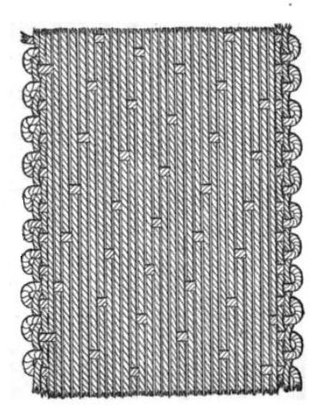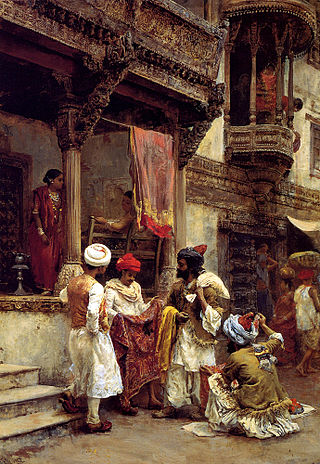
Siamoise is a term for various woven fabric varieties, usually cotton and linen blends, [1] with patterns such as checks and stripes. Siamoise was so named because it imitated clothing worn by 17th century Siamese ambassadors. [2]

Siamoise is a term for various woven fabric varieties, usually cotton and linen blends, [1] with patterns such as checks and stripes. Siamoise was so named because it imitated clothing worn by 17th century Siamese ambassadors. [2]
At first, Siamoise was made with silk in warp and cotton filling yarn. The fabric resembled the clothing of the Siamese (Thai) ambassadors who visited King Louis XIV in 1684 and 1686. That is why the name 'Siamoise' was given to it. [3]
Initially, the fabric was a combination of silk and cotton, and the silk warp weakened the material. Replacing the silk with linen produced a stronger fabric that was highly successful. [3]
Since then, Siamoise has undergone many additions such as linen and cotton patterns, varied stripes, and checks and blends of different fibers such as silk and wool. [2] [4] [5]
The Siamese Embassy to France in 1686 had brought to the Court samples of multicolor Thai Ikat textiles. These were enthusiastically adopted by the French nobility to become Toiles flammées or Siamoises de Rouen, often with checkered blue-and-white designs. After the French Revolution and its dislike for foreign luxury, the textiles were named "Toiles des Charentes" or cottons of Provence. [6]

Textile is an umbrella term that includes various fiber-based materials, including fibers, yarns, filaments, threads, different fabric types, etc. At first, the word "textiles" only referred to woven fabrics. However, weaving is not the only manufacturing method, and many other methods were later developed to form textile structures based on their intended use. Knitting and non-woven are other popular types of fabric manufacturing. In the contemporary world, textiles satisfy the material needs for versatile applications, from simple daily clothing to bulletproof jackets, spacesuits, and doctor's gowns.

Velvet is a type of woven fabric with a dense, even pile that gives it a distinctive soft feel. Historically, velvet was typically made from silk. Today, velvet can be made from silk, linen, cotton, wool, synthetic fibers, silk-cotton blends, or synthetic-natural fiber blends.

A satin weave is a type of fabric weave that produces a characteristically glossy, smooth or lustrous material, typically with a glossy top surface and a dull back; it is not durable, as it tends to snag. It is one of three fundamental types of textile weaves alongside plain weave and twill weave.
Ikat is a dyeing technique from Southeast Asia used to pattern textiles that employs resist dyeing on the yarns prior to dyeing and weaving the fabric. In Southeast Asia, where it is the most widespread, ikat weaving traditions can be divided into two general groups of related traditions. The first is found among Daic-speaking peoples. The second, larger group is found among the Austronesian peoples and spread via the Austronesian expansion to as far as Madagascar. It is most prominently associated with the textile traditions of Indonesia in modern times, from where the term ikat originates. Similar unrelated dyeing and weaving techniques that developed independently are also present in other regions of the world, including India, Central Asia, Japan, Africa, and the Americas.

Damask is a woven, reversible patterned fabric. Damasks are woven by periodically reversing the action of the warp and weft threads. The pattern is most commonly created with a warp-faced satin weave and the ground with a weft-faced or sateen weave. Fabrics used to create damasks include silk, wool, linen, cotton, and synthetic fibers, but damask is best shown in cotton and linen. Over time, damask has become a broader term for woven fabrics with a reversible pattern, not just silks.

Crêpe, also spelled crepe or crape, is a silk, wool, or synthetic fiber fabric with a distinctively crisp and crimped appearance. The term "crape" typically refers to a form of the fabric associated specifically with mourning. Crêpe was also historically called "crespe" or "crisp".

Kasuri (絣) is the Japanese term for fabric that has been woven with fibers dyed specifically to create patterns and images in the fabric, typically referring to fabrics produced within Japan using this technique. It is a form of ikat dyeing, traditionally resulting in patterns characterized by their blurred or brushed appearance.

Plain weave is the most basic of three fundamental types of textile weaves. It is strong and hard-wearing, and is used for fashion and furnishing fabrics. Fabrics with a plain weave are generally strong, durable, and have a smooth surface. They are often used for a variety of applications, including clothing, home textiles, and industrial fabrics.
The manufacture of textiles is one of the oldest of human technologies. To make textiles, the first requirement is a source of fiber from which a yarn can be made, primarily by spinning. The yarn is processed by knitting or weaving, which turns it into cloth. The machine used for weaving is the loom. For decoration, the process of colouring yarn or the finished material is dyeing. For more information of the various steps, see textile manufacturing.
[[File:|thumb||alt=]] A sampot, The national costume of Cambodia is the sampot, or Cambodian sarong. It is handwoven and comes in both loose and fitted styles and is worn over a shirt at the waist. The fabric used is usually silk, cotton, or a combination of both. The sampot for women is similar to the sarongs of Laos and Thailand. There are many different styles of sampot.The national costume of Cambodia is the sampot, or Cambodian sarong. It is handwoven and comes in both loose and fitted styles and is worn over a shirt at the waist. The fabric used is usually silk, cotton, or a combination of both. The sampot for women is similar to the sarongs of Laos and Thailand. There are many different styles of sampot. pha nung.
Mockado is a woollen pile fabric made in imitation of silk velvet from the mid-sixteenth century. Mockado was usually constructed with a woollen pile on a linen or worsted wool warp and woollen weft, although the ground fabric could be any combination of wool, linen, and silk. Mockado was used for furnishings and carpeting, and also for clothing such as doublets, farthingales, and kirtles.
Brilliantine is a lightweight, mixed-fibre fabric popular from the mid-19th century into the early 20th century.

In early modern France, Orientalism refers to the interaction of pre-modern France with the Orient, and especially the cultural, scientific, artistic and intellectual impact of these interactions, ranging from the academic field of Oriental studies to Orientalism in fashions in the decorative arts.

The Siamese embassy to France in 1686 was the second such mission from the Kingdom of Siam. The embassy was sent by King Narai and led by ambassador Kosa Pan. This embassy was preceded by the First Siamese Embassy to France, composed of two Siamese ambassadors and Father Bénigne Vachet, who had left Siam for France on January 5, 1684.

Odisha Ikat, is a kind of ikat known as Bandhakala and Bandha, a resist dyeing technique, originating from Indian state of Odisha. Traditionally known as "Bandhakala"', "Bandha", '"Bandha of Odisha", it is a geographically tagged product of Odisha since 2007. It is made through a process of tie-dyeing the warp and weft threads to create the design on the loom prior to weaving. It is unlike any other ikat woven in the rest of the country because of its design process, which has been called "poetry on the loom". This design is in vogue only at the western and eastern regions of Odisha; similar designs are produced by community groups called the Bhulia, Kostha Asani, and Patara. The fabric gives a striking curvilinear appearance. Saris made out of this fabric feature bands of brocade in the borders and also at the ends, called anchal or pallu. Its forms are purposefully feathered, giving the edges a "hazy and fragile" appearance. There are different kinds of bandha saris made in Odisha, notably Khandua, Sambalpuri, Pasapali, Kataki and Manibandhi.

Sussi or susi is a term for multicolored striped or checked cloth produced mainly in Sindh. Sussi is thin handloom fabric made of cotton, silk, or a blend of the two, with colored warp stripes. Sindh region was known for its production and exports during the Mughal period. Sussi was most often made with red and blue, blue and white, or green and white stripes, but other patterns were also produced. The fabric was exported to England, where sousaes were in great demand in the 18th century.
Qutni(cuttanee, couthnys, Koetnies, Kutni) is an old silk and cotton mix cloth with a striped pattern. Qutni is a satin weave structure with silk in warp and cotton in the weft. It was made In Gujarat, India. Qutni was also produced at Damascus, Aleppo, Hama.

Mashru is a woven cloth that is a blend of silk and cotton. It was historically a hand-woven satin silk fabric variety found in the Indian subcontinent, and its proper use is described in the 16th-century Ain-i-Akbari.

A tanmono is a bolt of traditional Japanese narrow-loomed cloth. It is used to make traditional Japanese clothes, textile room dividers, sails, and other traditional cloth items.
A blend is a mixture of two or more fibers. In yarn spinning, different compositions, lengths, diameters, or colors may be combined to create a blend. Blended textiles are fabrics or yarns produced with a combination of two or more types of different fibers, or yarns to obtain desired traits and aesthetics. Blending is possible at various stages of textile manufacturing. The term, blend, refers to spun fibers or a fabric composed of such fibers. There are several synonymous terms: a combination yarn is made up of two strands of different fibers twisted together to form a ply; a mixture or mixed cloth refers to blended cloths in which different types of yarns are used in warp and weft sides.